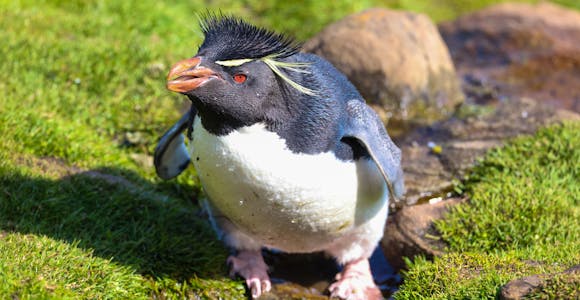
Saunders Island
Saunders Island offers the chance to see four penguin species in one Falklands location, as well as a black-browed albatross colony
Discover More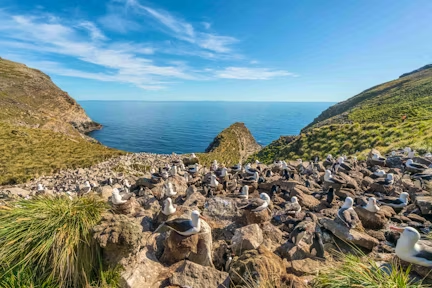
The black-browed albatross colony at West Point
West Point island is well named as it sits at the northwestern tip of the Falklands, giving it the perfect location for call expedition cruise ships.
The island has traditionally been used for sheep farming, but not relies heavily on the tourists who come here to see its cliffside colony of black-browed albatrosses. It's a distinct improvement on the first visitors in the 18th century who came for the sealing or rendering the local penguins into oil.
The human population of West Point can be counted on the fingers of one hand and live in the farmhouse near the jetty (note the old whale vertebrae stacked by the farmhouse wall). They lay on an extensive spread of tea and cakes for cruise ship passengers. On now account should this be missed: the scones topped with homemade jam are almost worth the trip to the Falklands alone. It's mind-boggling to ponder out just how much baking needs to happen in the small farmhouse kitchen to feed an entire season of hungry visitors.
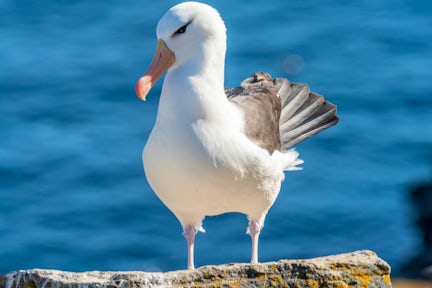
Black-browed albatross
Around 2,000 pairs of black-browed albatrosses nest at West Point. They sit on tall mud-pot nests, incubating a single egg that's laid at the start of the austral summer. The birds mate for life and can live up to 50 years. They're one of the handsomest of the albatrosses, with clean white feathers and smoky eyes make them look as if they have just come from a particularly elegant nightclub.
A marked path leads through from the walking track on the heath to the colony, through thick tussac grass that's often higher than your head. There are several viewing points where the grass suddenly opens up and you find yourself just a few metres away from the birds. It's essential to remain quiet when watching so as not to disturb them, but the experience of being so close usually invokes a joyfully reverent silence among visitors. Don't forget to look up to see the birds constantly coming in to land and taking off.
The albatrosses share their colony with around 500 pairs of rockhopper penguins, who climb the nearby cliff using their sharp crampon-like claws. Take extra care when walking near the colony: it's not unknown for a penguin to unexpectedly hop out from the tussac.
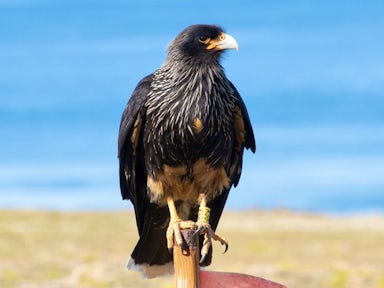
Striated caracara at West Point
While everyone comes to West Point to see the black-browed albatrosses and their rockhopper penguin neighbours, there is plenty of other good birding to be had here.
Upland geese are a common site both on the slopes around the harbour and on the walk to the colony; if you visit at the start of the summer you've got a good chance of seeing of fluffy goslings in a train behind their parents. Long-tailed meadowlarks are instantly recognisable for the scarlet breast worn by the male, which give them the local name of military starlings. Another common species with a Falklands twist is the Johnny Rook, more properly known as the striated caracara. This falcon is rare on the South American mainland, but common here: look out for them perching on fence posts. Turkey vultures can also be sometimes seen sunning themselves with outstretched wings on the roofs of the farm buildings. They predate on the albatross and penguin chicks, as do brown skuas. Smaller birds to look out for include the Falklands thrush and grass wren.
Price Match Promise - We’ll match any price you find elsewhere for the same trip
Expedition cruise ships moor in the shelter of West Point harbour, where there is a jetty that allows visitors to make dry landings rather than wading ashore on a beach. A track leads uphill past a small group of farm buildings towards the albatross colony. It's a walk of around 45 minutes to the colony, but there is a land rover that ferries back and forth from the farm throughout the duration of the landing. The drive takes less than ten minutes and is perfect for those less able to walk longer distances or just want to hurry back to the farmhouse after birdwatching for the tea and cake.
NOTE: Ship itineraries and visits to specific landing sites in the Falklands can never be guaranteed. Plans can change as fast as the weather in the South Atlantic: decisions on which locations to visit are always made on the day by the ship's captain and expedition leader.

Saunders Island offers the chance to see four penguin species in one Falklands location, as well as a black-browed albatross colony
Discover More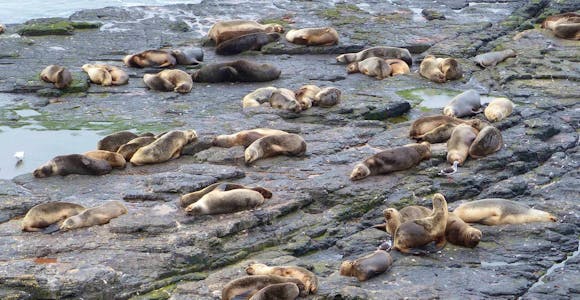
The narrow curved line of Bleaker Island is a great place for birdwatching, with three species of penguin, an enormous imperial shag colony and plenty of waterfowl.
Discover More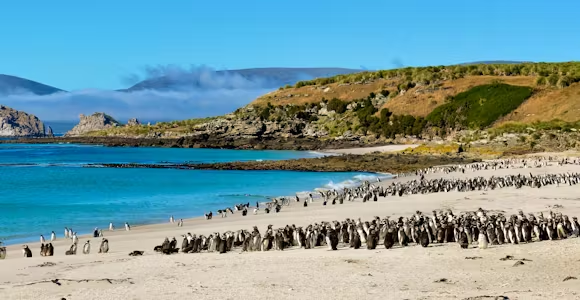
The white sandy beaches of Carcass Island are a popular draw for expedition cruise ships, with visitors coming here for the colonies of magellanic and gentoo penguins.
Discover More
The pocket-sized capital of the Falkland Islands is full of history and easily explored on foot by visitors from expedition cruise ships.
Discover MoreWe'll spend some time listening to your aspirations, then discuss the kind of experience that might suit you.
Next we'll discuss the options, shortlist the best trips for you and present you our impartial recommendations.
We'll place a 24 hour hold on your preferred option - without obligation - whilst we talk through the details.